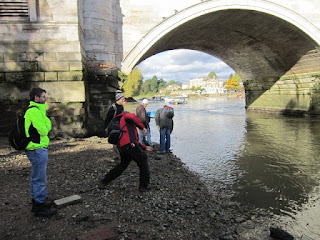Manor Park is a Green Flag park and a wonderful open space for the local community. There's plenty of woodland, including some younger plantations which are in need of a little attention. Our work site for the day, close the railway embankment, consists of oak, sweet chestnut, hawthorn, elder, alder, and ash. Despite concerns about ash die-back, which seems far more widespread than at first thought, the self-seeded ash saplings at Manor Park were growing much too close together which had resulted in all the trees becoming very tall and skinny. As such, a little thinning was called for to give the healthier specimens, of all species, a better chance to mature. This will also help to improve the age-structure of the woodland as new tree seeds germinate as a result of more light reaching the ground. Furthermore, this should also encourage wild flowers to germinate, which in turn will improve the insect and bird life within the woodland.
In terms of improving access for local people, this patch of woodland had become rather notorious (according to passing dog-walkers) as a haven for 'couples'. By opening up the woodland, and removing some collapsed wire fencing, more people will be encouraged to explore the wood and enjoy its tranquility, which should discourage anti-social behaviour. We also collected a bag of rubbish that was taken away for recycling. Unfortunately and bizarrely, the best and most mature portion of the woodland has been sold for private use, which may threaten the entire area. We hope the owner and Kingston Council will work to ensure that this valuable habitat is maintained for use by all and is not subject to inappropriate development. If nothing else, a toad that we disturbed will need to navigate its way back to the pond to breed in the spring.
There's still a lot to be done at Manor Park, including improving the nearby pond, so we hope to make a return visit soon, perhaps in February 2013.
Ash trees tightly packed, with little light reaching the ground (September 2012).
The team (left to right): John, Nicola, Gerrard, Cllr Ken Smith (St. James ward).
John caught red-handed.
Gerrard ('Oh, I'm a lumberjack and I'm okay...').
A toad was rudely awoken when we removed the dilapidated wire fence.
The thinned-out ash trees. They're still too close together, but we'll return to reassess the situation next year.
A new path leads walkers through the woodland.
A nearby wall mural paints an interesting picture.


































